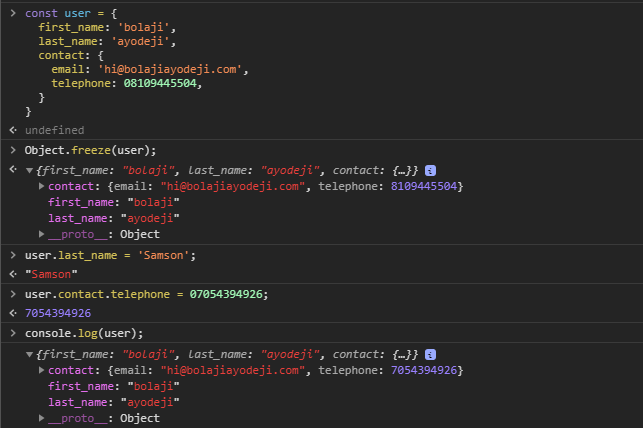ES6 has brought several new features and methods into JavaScript since its release. These features have better improved our workflow and productivity as JavaScript developers. Amongst these new features are Object.freeze() method and const.
It is argued among a few developers especially newbies that these two feature works the same way, but they actually don’t. Object.freeze() and const work differently, and I'll show you how in this article.
Overview
const and Object.freeze() are totally different.
- const behaves like
let. The only difference is, it defines a variable that cannot be reassigned. Variables declared byconstare block-scoped and not function scoped like variables declared withvar. - Object.freeze() takes an object as an argument and returns the same object as an immutable object. This implies that no properties of the object can be added, removed, or changed.
Mutable objects have properties that can be changed. Immutable objects have no properties that can be changed after the object is created.
Demystifying Const
const user = 'Bolaji Ayodeji'
user = 'Joe Nash'
This would throw an Uncaught TypeError because we are trying to reassign the variable user, which was declared with the const keyword. This is not valid!

Originally, this would work with var or let but will not with const.
The problem with const
When working with Objects, using const only prevents reassignment and not immutability (the ability to prevent changes to the state and properties of an object after it's created).
Consider the code below. We have declared a variable using the const keyword and assigned an object named user to it.
const user = {
first_name: "bolaji",
last_name: "ayodeji",
email: "hi@bolajiayodeji.com",
net_worth: 2000,
};
user.last_name = 'Samson';
// this would work, user is mutable!
user.net_worth = 983265975975950;
// this would work too, user is mutable and getting rich :)!
console.log(user);
// user is mutated

Although we can’t reassign this variable called object, we can still mutate the object itself.
const user = {
user_name: 'bolajiayodeji'
}
// won't work

We definitely would want to have objects with properties that cannot be modified or deleted after creation. const cannot do this, and this is where Object.freeze() saves the day :).
Demystifying Object.freeze()
To disable any changes to the object, we need Object.freeze().
const user = {
first_name: "bolaji",
last_name: "ayodeji",
email: "hi@bolajiayodeji.com",
net_worth: 2000,
};
Object.freeze(user);
user.last_name = 'Samson';
// this won't work, user is immutable!
user.net_worth = 983265975975950;
// this won't work too, user is still immutable and broke :(!
console.log(user);
// user is immutable

The problem with Object.freeze()
Object.freeze() is a bit shallow. An object with nested properties is not actually frozen when Object.freeze() is applied. You will need to apply Object.freeze() on nested objects to protect them recursively.
const user = {
first_name: 'bolaji',
last_name: 'ayodeji',
contact: {
email: 'hi@bolajiayodeji.com',
telephone: 08109445504,
}
}
Object.freeze(user);
user.last_name = 'Samson';
// this won't work, user is still immutable!
user.contact.telephone = 07054394926;
// this will work because the nested object is not frozen
console.log(user);

So Object.freeze() doesn't fully freeze an object when it has properties that are nested. To completely freeze objects and their nested properties, you can write your own library or use already created libraries like Deepfreeze or immutable-js.
Conclusion
I hope you've learned why const and Object.freeze() are not the same. const prevents reassignment and Object.freeze() prevents immutability.
Thanks for reading; cheers!

